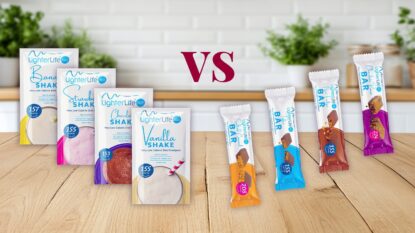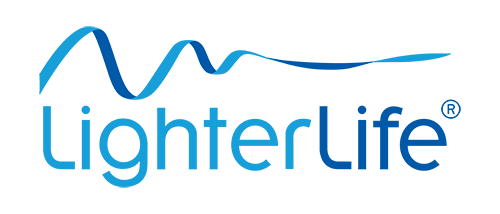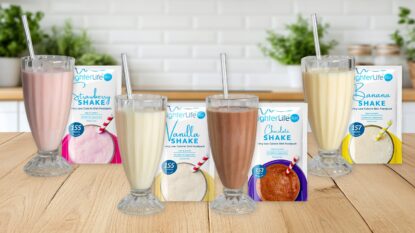
VLCD Shakes vs Bars – Which Works Best?
When you’re on a Very Low Calorie Diet (VLCD), your meal choices can become a focal point of the day. Trying new flavours and product types is very exciting and working your way through the range day by day until you find your favourites, takes time. Two of the most popular options on many VLCDs are shakes and bars. Convenient, nutritionally balanced, and easy to fit into your daily routine – but is one better than the other?
In this article, we’ll explore the differences between VLCD shakes and bars. We’ll look at when to choose one over the other, and how both of these products can fit into your personal weight-loss journey.
What’s the Purpose of VLCD Products?
Before looking at our shakes and bars, it may help to understand why our range uses these types of products. And this is because on a VLCD, traditional meals made with conventional foods, are replaced with formula-based, nutritionally complete products. These are designed to:
- Provide all the essential nutrients your body needs
- Keep your calorie intake very low (typically under 800 kcal per day)
- Help support safe and effective weight loss
Although there are several different types of VLCD products, shakes and bars are two of the most common types and each has its own strengths depending on your lifestyle, taste preferences and routine.
What Are VLCD Shakes?
Shakes are formula-based powdered drinks that you mix with water to create a smooth, filling meal. They come in a variety of flavours including chocolate, vanilla, banana and strawberry and you can enjoy them either cold or slightly warmed if you prefer.
Advantages of Shakes:
- Quick to prepare: Just add water and shake or blend
- Hydrating: Helps you increase your fluid intake
- Soothing: Many people find drinking a shake, especially a warm one in the evening, to be quite soothing
- Light texture: Good for those who prefer drinks over solid food
Things to Consider:
- You need to ensure you carry, or have access to water and that you have a shaker or blender to hand
- May not feel as satisfying if you prefer your meals to be chewier
- Less practical if you’re on the move and can’t prepare it in advance
What Are VLCD Bars?
Bars are ready-to-eat meal replacements that come in a solid form. They can take the form of either a cereal style bar, or they resemble a paste bar and come in a chocolate or yoghurt coating. Popular flavours include peanut, double chocolate, or salted caramel.
Advantages of Bars:
- No preparation needed: Eat straight from the wrapper
- Portable: Ideal for work, travel, or busy schedules
- Chewy and satisfying: Great if you prefer chewing and eating solid food
- Can help with sweet cravings: Many bars feel like a treat
Things to Consider:
- They are less hydrating then a shake and need to be consumed alongside a drink suitable for a VLCD to ensure you keep your fluid intake up.
- Some people can find them less filling given the volume consumed is lower than with a liquid meal
So, Which One Is Better?
There’s no one-size-fits-all answer, and from a compositional point of view, both shakes and bars are almost identical nutritionally. The best choice for you will depend on your personal preferences, lifestyle and even the time of day.
Here’s a breakdown to help you decide:
| Situation | Better Choice |
| Rushing out the door in the morning | Bar |
| Want something warm and comforting | Shake |
| Travelling or commuting | Bar |
| Trying to increase fluid intake | Shake |
| Mid-afternoon energy dip | Either – your choice |
| Managing sweet cravings | Bar |
| Feeling bloated/needing something light | Shake |
Many people whilst following a VLCD, that a mix of both on a day to day basis is what works best. Having a choice between product types, and then between different flavour within each product types, can help prevent boredom and will keep your VLCD plan feeling varied and manageable, as well as satisfying and tasty.
Can You Use Both in a Day?
Yes. As long as you stick to the number of products recommended by your VLCD plan, you can mix shakes and bars to suit your needs.
For example:
- Breakfast: Vanilla shake
- Lunch: Chocolate VLCD bar
- Dinner: Soup or savoury VLCD meal
- Evening snack: Another shake or bar
This flexibility can help you stay on track while making your plan fit your lifestyle.
Taste and Texture: Personal Preferences Matter
Taste is of course subjective. Some people love the creamy, smooth texture of shakes, whilst others prefer the crunch or chew of a bar. It may take a few days to discover your favourite textures and flavours.
Tips:
- Try a variety pack if it’s available.
- Ask your mentor or group for product reviews, and any ideas on special preparation to mix it up a bit.
- Don’t give up on a flavour after one try—your taste buds may adapt.
VLCD Shakes and Bars: Nutritional Profile
Both shakes and bars on approved VLCD programmes are:
- Balanced for protein, fibre, carbs and essential fats and vitamins.
- Low in calories (usually 200 or fewer per product)
- Formulated to help you feel satisfied and support safe, supervised weight loss.
It’s important to follow the instructions from your provider and not mix and match with non-approved products.
What About Hunger?
Some people are concerned that just eating individual meal replacements only each day, won’t fill them up. However, in reality formula-based weight loss programmes which incorporate VLCDs are scientifically proven to help manage hunger, especially once your body begins to burn fat for fuel.
If you find yourself feeling peckish:
- Space your meals evenly throughout the day
- Drink more water
- Talk to your consultant about how you’re feeling
Often, hunger fades once your body adjusts.
Tips to Get the Most from Your VLCD Products
- Stay consistent: Stick to your plan and use your products as directed
- Keep a journal: Track what you eat and how you feel
- Use support: Reach out to your mentor or group encouragement
- Avoid temptation: Keep other foods out of reach if they make you slip
Final Thoughts
Shakes and bars are both useful tools on your VLCD journey. Whether you prefer a creamy shake or a chewy bar, what matters most is staying committed to your plan and using the support available to you.
By making choices that suit your routine and preferences, you can stay on track and work towards your goals with confidence. Thinking of starting a VLCD – find out more.




